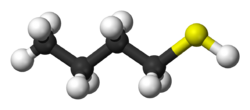Chemistry:Butanethiol

| |

| |
| Names | |
|---|---|
| Preferred IUPAC name
Butane-1-thiol | |
| Other names
Butyl mercaptan
n-Butyl mercaptan 1-Butanethiol Thiobutyl alcohol Mercaptobutane n-Butanethiol 1-Mercaptobutane | |
| Identifiers | |
3D model (JSmol)
|
|
| ChemSpider | |
PubChem CID
|
|
| UNII | |
| |
| |
| Properties | |
| C4H10S | |
| Molar mass | 90.18 g·mol−1 |
| Appearance | Clear liquid |
| Odor | cabbage-like, skunk-like, garlic-like[2] |
| Density | 0.83679 g/mL |
| Melting point | −115.8 °C (−176.4 °F; 157.3 K) |
| Boiling point | 98.2 °C (208.8 °F; 371.3 K) |
| Slightly soluble (0.06% at 20°C)[2] | |
| Vapor pressure | 35 mmHg (20°C)[2] |
| Hazards | |
| NFPA 704 (fire diamond) | |
| Flash point | 2 °C; 35 °F; 275 K [2] |
| Lethal dose or concentration (LD, LC): | |
LC50 (median concentration)
|
4020 ppm (rat, 4 hr) 2500 ppm (mouse, 4 hr) 770 ppm (dog, 30 min)[3] |
| NIOSH (US health exposure limits): | |
PEL (Permissible)
|
TWA 10 ppm (35 mg/m3)[2] |
REL (Recommended)
|
C 0.5 ppm (1.8 mg/m3) [15-minute][2] |
IDLH (Immediate danger)
|
500 ppm[2] |
Except where otherwise noted, data are given for materials in their standard state (at 25 °C [77 °F], 100 kPa). | |
| Infobox references | |
Butanethiol, also known as butyl mercaptan, is a volatile, clear to yellowish liquid with a fetid (extremely foul-smelling) odor, commonly described as "skunk" odor. In fact, butanethiol is structurally similar to several major constituents of a skunk's defensive spray but is not actually present in the spray.[4] The scent of butanethiol is so strong that the human nose can easily detect it in the air at concentrations as low as 10 parts per billion. The threshold level for 1-butanethiol is reported as 1.4 ppb[5]
Chemistry
Butanethiol is chemically classified among the thiols, which are organic compounds with molecular formulas and structural formulas similar to alcohols, except that sulfur-containing sulfhydryl group (-SH) replaces the oxygen-containing hydroxyl group (-OH) in the molecule. Butanethiol's basic molecular formula is C4H9SH, and its structural formula is similar to that of the alcohol n-butanol. Butanethiol is prepared by the free radical catalyzed addition of hydrogen sulfide to 1-butene. Commercially, this is performed using ultraviolet light. Butanethiol is a thiol of low molecular weight, and it is highly flammable.
Uses
Butanethiol is used as an industrial solvent,[citation needed] and as an intermediate for cotton defoliants.[6] It is sometimes placed in the "stink bombs" and "stink perfumes" for pranksters.
Safety
Butanethiol is a very noxious and caustic chemical compound, and at sufficiently high concentrations, it produces serious health effects in both humans and animals, especially as a result of prolonged exposure. Higher concentrations can lead to unconsciousness and coma after prolonged exposure. Contact with the skin and mucous membranes causes burns, and contact with the eyes can lead to blurred vision or complete blindness.[citation needed]
Inhalation may cause weakness, confusion, cough, dizziness, drowsiness, headache, nausea, vomiting, and shortness of breath. The substance irritates the eyes, the skin, and the respiratory tract. It may cause effects on the thyroid and the nervous system and could cause lowering of consciousness.[7]
See also
- tert-Butylthiol (tert-butyl mercaptan)
Notes
- ↑ Merck Index, 12th Edition, 1611.
- ↑ 2.0 2.1 2.2 2.3 2.4 2.5 2.6 NIOSH Pocket Guide to Chemical Hazards. "#0083". National Institute for Occupational Safety and Health (NIOSH). https://www.cdc.gov/niosh/npg/npgd0083.html.
- ↑ "n-Butyl mercaptan". Immediately Dangerous to Life and Health Concentrations (IDLH). National Institute for Occupational Safety and Health (NIOSH). https://www.cdc.gov/niosh/idlh/109795.html.
- ↑ Andersen K. K., Bernstein D. T. (1978). "1-Butanethiol and the Striped Skunk". Journal of Chemical Education 55 (3): 159–160. doi:10.1021/ed055p159.
- ↑ Devos, M; F. Patte; J. Rouault; P. Lafort; L. J. Van Gemert (1990). Standardized Human Olfactory Thresholds. Oxford: IRL Press. pp. 34. ISBN 0199631468.
- ↑ National Library of Medicine HSDB Database. "Merphos". National Library of Medicine. http://toxnet.nlm.nih.gov/cgi-bin/sis/search/a?dbs+hsdb:@term+@DOCNO+1777. Retrieved 2012-05-17.
- ↑ "n-BUTYL MERCAPTAN". International Chemical Safety Cards. National Institute for Occupational Safety and Health. https://www.cdc.gov/niosh/ipcsneng/neng0018.html. Retrieved January 11, 2012.
References
External links

